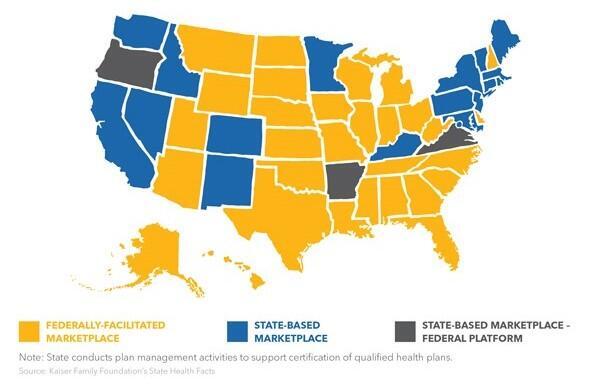While the proposed rule touches on a range of topics, we invite health plans to pay special attention to the proposed provisions that apply to issuers offering Qualified Health Plans (QHPs) through the Federally-facilitated Exchanges (FFE) and State-based Exchanges on the Federal platform (SBE-FP) beginning plan year 2023.
The rule proposes that CMS, not individual states, conduct network adequacy reviews of QHPs in most FFM states. These changes would represent a significant change for health plans who offer products on the Exchange in any of the 30 FFE states, or any of the 3 SBE-FP states. In this overview, we will discuss these provisions and other important provisions in the Key Takeaways section below.
Key Takeaways
The following sections of the proposed rule have the largest impact on health plan provider networks. These sections include–
- Network Adequacy
- Time and Distance Standards
- Appointment Wait Times
- Tiered Networks
- Telehealth
- Essential Community Providers (ECPs)

NETWORK ADEQUACY FOR FFE QHP
The rule proposes that CMS conduct network adequacy reviews of QHPs offered through the FFEs, except for FFEs in certain states. Network adequacy requirements and reviews in the 18 non-federal, State-based Exchanges (SBE) would remain with those states. CMS would not conduct network adequacy reviews in FFE states that enforce network adequacy standards that are at least as stringent as the federal standards and that the reviews are conducted prior to QHP certification. The determination of the states that have more stringent requirements will likely be the result of state surveys conducted by CMS.

TIME AND DISTANCE STANDARDS
The rule proposes to adopt time and distance standards that are generally consistent with Medicare Advantage standards. However, the rule proposes adding provider specialties above and beyond Medicare Advantage, which are:
- Emergency Medicine
- Outpatient Clinical Behavioral Health
- Pediatric Primary Care
- Urgent Care
The standards would be calculated at the county level and vary by county designation. CMS would use a county type designation method that is based upon the population size and density parameters of individual counties. The county-specific requirements that health plans would be required to meet would be detailed in future guidance and would be informed by industry standards. Health plans that are unable to meet the specified standards would be able to submit a justification to account for variances.
The time and distance standards would apply to the provider specialty lists contained in the tables below.
Proposed Individual Provider Specialty List for Time and Distance Standards
- Allergy and Immunology
- Cardiology
- Cardiothoracic Surgery
- Chiropractor
- Dental
- Dermatology
- Emergency Medicine
- Endocrinology
- ENT/Otolaryngology
- Gastroenterology
- General Surgery
- Gynecology, OB/GYN
- Infectious Diseases
- Nephrology
- Neurology
- Neurosurgery
- Occupational Therapy
- Oncology – Medical, Surgical
- Oncology – Radiation
- Ophthalmology
- Orthopedic Surgery
- Outpatient Clinical Behavioral Health (Licensed, accredited, or certified professionals)
- Physical Medicine and Rehabilitation
- Physical Therapy
- Plastic Surgery
- Podiatry
- Primary Care – Adult
- Primary Care – Pediatric
- Psychiatry
- Pulmonology
- Rheumatology
- Speech Therapy
- Urology
- Vascular Surgery
Proposed Facility Specialty List for Time and Distance Standards
- Acute Inpatient Hospitals (Must have Emergency services available 24/7)
- Cardiac Catheterization Services
- Cardiac Surgery Program
- Critical Care Services – Intensive Care Units (ICU)
- Diagnostic Radiology (Free-standing; hospital outpatient; ambulatory health facilities with Diagnostic Radiology)
- Inpatient or Residential Behavioral Health Facility Services
- Mammography
- Outpatient Infusion/Chemotherapy
- Skilled Nursing Facilities
- Surgical Services (Outpatient or ASC)
- Urgent Care
APPOINTMENT WAIT TIMES
The rule proposes adopting standard appointment wait times for a shortlist of service categories informed by Medicare Advantage. The proposed specialties and appointment wait times include
- Behavioral Health Services – 10 calendar days
- Primary Care (Routine) – 15 calendar days
- Specialty Care (Non-Urgent) – 30 calendar days
The specific wait time requirements that health plans would be required to meet would be detailed in future guidance and informed by industry standards. Health plans would need to attest that they meet these standards as part of the certification process. The rule proposes to conduct post-certification reviews to monitor compliance with these standards. These compliance reviews would occur in response to complaints or through random sampling. Health plans that are unable to meet the standards would be able to submit a written justification to account for variances.
TIERED NETWORKS
The rule proposes that, for health plans that use tiered networks, to count toward the health plan’s satisfaction of the network adequacy standards, providers must be contracted within the network tier that results in the lowest cost sharing for the member. For health plans with two network tiers, where cost sharing is lower for preferred providers, only preferred providers would be counted towards network adequacy standards.
TELEHEALTH
The rule proposes to require health plans to submit information about whether its network providers offer telehealth services. CMS states that the data would be intended to help inform future development of telehealth standards. CMS stresses that health plans should not construe this proposal to mean that telehealth services could be counted in place of in-person service access for the purpose of network adequacy standards.
ESSENTIAL COMMUNITY PROVIDERS
The rule proposes that the required ECP provider participation standard be raised from 20% to 35% of available ECPs based on the applicable ECP list, including approved ECP write-ins that would also count toward a health plan’s satisfaction of the 35% threshold.
CMS would consider a health plan to have satisfied the standard if it contracts with at least 35% of available ECPs in each service area. The calculation methodology would remain unchanged. The ECP list will be based on data maintained by CMS as well as provider data that CMS receives directly from providers through the ECP petition process. CMS anticipates that any health plans falling short of the 35% threshold could satisfy the standard by using ECP write-ins and written justifications.
The rule also proposes that, for health plans that use tiered networks, to count toward its satisfaction of the ECP standard, ECPs must be contracted within the network tier that results in the lowest cost sharing for members. For plans with two network tiers, only the preferred network would be counted towards ECP standards.
Additionally, the rule proposes that health plans could comply with the requirement to offer contracts to at least one ECP in the category of “other ECP providers” by offering a contract to a Substance Use Disorder Treatment Center. CMS is also requiring health plans to offer contracts to at least one ECP in each of the ECP categories1.
PLEASE NOTE THIS PROPOSAL IS NOT FINAL. THAT MEANS IT IS NOT YET LAW AND MAY CHANGE.
CMS is actively soliciting comments through January 27, 2022. We expect CMS will finalize the rule by March 2022 after reviewing comments. This timing will immediately precede the opening of network certification requests currently expected to open in April 2022 for Plan Year 2023.
Read the 2023 Letter to Issuers in the Federally-facilitated Exchanges

QHP UPDATE SOLUTION: HOW QUEST ANALYTICS CAN HELP
Quest Analytics is your partner in network adequacy for QHP compliance in any state, but especially in the 30 FFE and 3 SBE-FP states. While we cannot predict what the final rule will hold, Quest Analytics will be ready to help you measure, manage and monitor your networks for compliance once the final rule will be put in place. Let us help you put a plan in place to address your organization’s strategy for meeting compliance. Schedule a complimentary strategy session today.
GEAR UP FOR CHANGES COMING TO ISSUERS IN THE FEDERALLY-FACILITATED EXCHANGES

Explore our QHP Marketplace Resource Hub to find the latest blogs, videos and other resources designed to keep your networks strong and your organization compliant.
EndNote
Federal law defines ECPs as providers that serve predominantly low-income, medically underserved individuals, and specifically include providers described in section 340B of the Public Health Service (PHS) Act and the Social Security Act. 340B Entities include safety net providers listed in the 340B Statute as eligible to purchase drugs at a discounted rate through the 340B Drug Pricing Program. CMS further clarified the law by identifying six ECP categories: (1) Federally Qualified Health Centers (FQHCs) and FQHC “Look-Alike” clinics; (2) Ryan White HIV/AIDS Program Providers; (3) Family Planning Providers; (4) Indian Health Providers; (5) Hospitals; and (6) Other ECP Providers including STD clinics, TB clinics, Hemophilia treatment centers, Black Lung clinics and other entities that serve predominately low-income, medically underserved individuals.






















